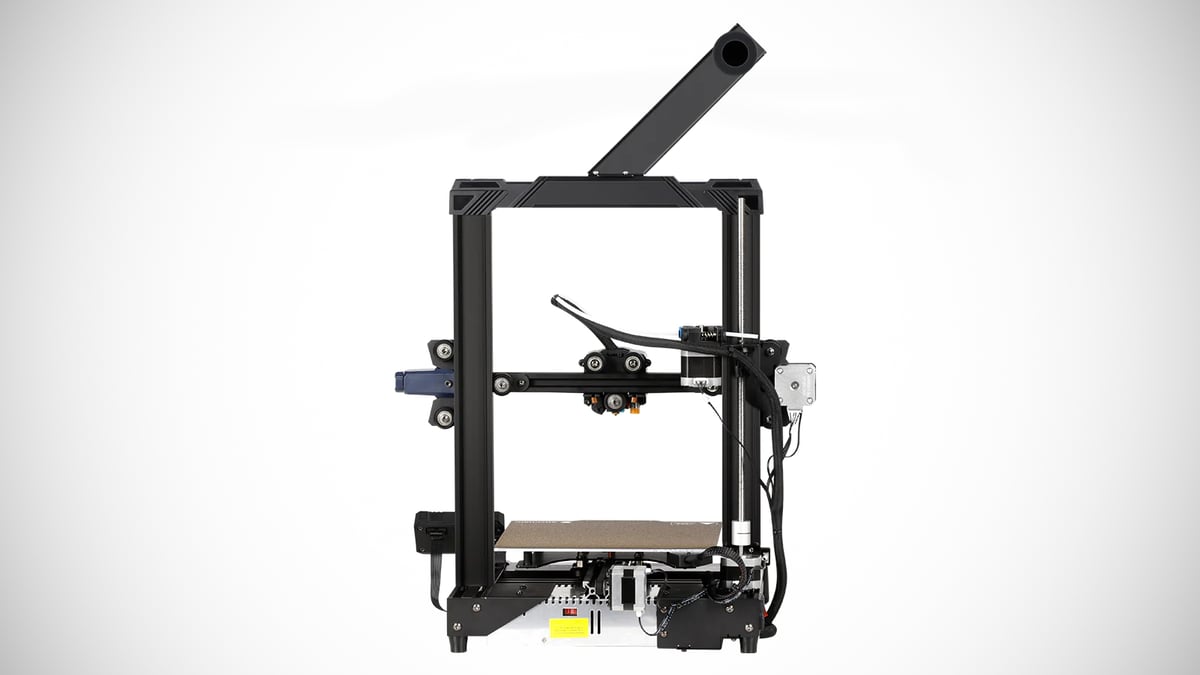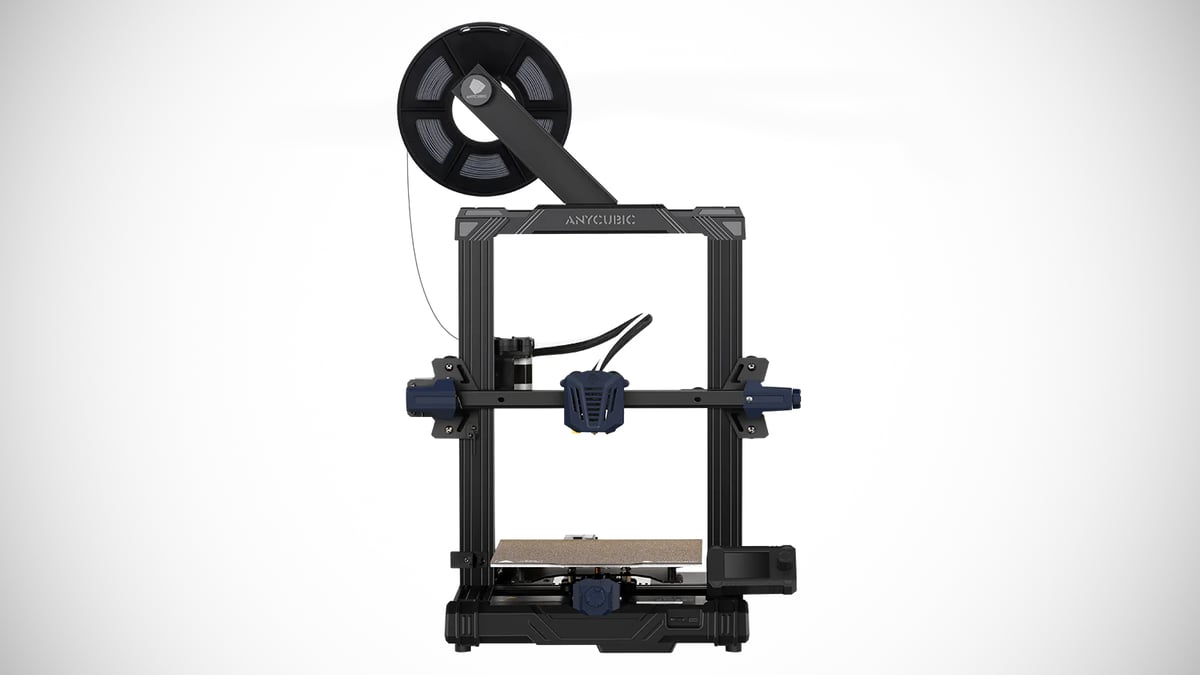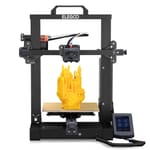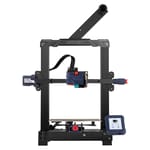Anycubic has had a fair amount of success with its Kobra lineup of FDM printers. They’re machines that manage to balance price and performance well.
Perhaps taking a page out of Creality’s playbook, the company has decided it needs to introduce another 220 x 220 x 250 mm bed slinging FDM printer. Another Kobra, of course, but this time reduced in price and with some reworked features. They’re calling it the Anycubic Kobra Go.
The new printer is essentially a Kobra, but with some features replaced with cheaper options. For starters, unlike the direct extruder on the Kobra, the Go will feature a Bowden extruder. Plus, instead of a touchscreen; you’ll have to do with a smaller, knob-driven screen. And, there is also a bit more assembly now involved than with the Kobra too.
However, the Kobra Go looks to be far from a downgrade. Features like a removable magnetic flex plate and automatic bed leveling via Anycubic’s induction leveling sensor, could help the Kobra Go find itself on the shortlist of beginner-friendly 3D printers. Currently on pre-sale, the Anycubic Kobra Go is available for less than $200.
Seekers of an entry-level 3D printer that doesn’t break the bank should read on for some more insights on the features of the Anycubic Kobra Go.
Features

Automatic bed leveling
Kobra Go features the same auto-leveling system as the original Kobra. Anycubic’s inductive leveling system uses a magnetic field to detect the proximity of metals. The system is called LeviQ here, a name that Anycubic attaches to various auto-leveling systems in its stable, regardless of the technology involved.
This induction system checks 25 points on the print bed, detects the unevenness, and then calculates how much the printer must compensate while printing.
Go doesn’t have leveling wheels underneath like the Kobra, but this inductive leveling system has worked great in the past and it should work here as well. Seeing it on a system at this price point is definitely a treat.
Build Volume, Temperatures, and Speed
Anycubic Kobra Go shares the same build volume as the Kobra – a reasonable printable area of 220 x 220 x 250 mm.
The original Kobra featured a direct extruder, while the Go is Bowden based. This change hasn’t affected the temperatures on the Kobra Go, which remains the same as the original. The hot end can achieve temperatures of up to 260 °C and 110 °C on the print bed.
Anycubic also claims maximum print speeds of 100 mm/s, which isn’t as insane as their 180 mm/s claimed top speed on the original Kobra. That claim came with a caveat of 80 mm/s average. In actuality, we don’t expect print speeds here to be anything different from any standard FDM printer.
PEI coated spring steel build plate
Polyetherimide-coated spring steel sheets are becoming an increasingly common spot on budget FDM printers. The textured variety primarily offers great adhesion and easy removal of stubborn prints, thanks to its flexibility. Of course, not all PEI-coated sheets work perfectly though.
If we take our experience with the seemingly identical print surface of the original Kobra into account, we would attest to the Go’s grainy print surface providing proper adhesion and easy removal of prints, albeit its coarse print surface might blitz the first layer detail. Only testing will reveal.
Bowden extruder
Unlike other Kobra series machines, the Go will not feature a dual-geared extruder. It instead features a single-gear Bowden extruder, which is a bit of a shame, as dual-gear extruders typically have a better grip on the filament and hence more pushing power. This can reduce extruder issues like skipped steps and filament grinding. Flexible filaments like TPU also tend to perform better with dual gears.
Anycubic’s current lineup of printers actually features an assortment of extruders and auto-leveling combinations. There is a direct extruder on the original Kobra and a Bowden-based extruder on the Kobra Plus and Kobra Max. The original Kobra has an induction-based leveling system, while the Plus and Max use strain gauge leveling. The Vyper also uses a Bowden and strain gauge. It’s easy to get confused.
A filament sensor is only listed as an option for the Kobra Go. How to get one is currently a bit of a mystery as there is no basic option to select it on their purchase page. We inquired about the sensor with Anycubic, and they informed us that the filament sensor is not part of the current pre-order.
DIY assembly
The Anycubic Kobra Go will be a complete DIY kit, which means, unlike the vast majority of modern 3D printers (that come partially assembled), this one will take a lot longer than 10 minutes to assemble. According to Anycubic, the assembly will take around an hour, possibly more for novices.
The company is terming it as “Funny DIY sessions,” but we think it might have just been cheaper to shove all the components in a smaller box and cut some extra costs.
Further Features
Additional features include:
- Resume function: The Go can also resume printing in case of power failure. We aren’t sure if the pause and resume functions are available as a function from the UI or if it just works with power failures.
- 2.4-inch color screen with knob controller: Going small on a screen where everyone is going bigger is a bold move. While the tiny 2.4-inch screen is aesthetically pleasing, some of the Go’s competitors have large color touchscreens on their budget printers.

Price

At this price, the Anycubic offers a pretty good range of features over something like a standard Creality Ender 3. However, against more modern competitors, things get a little more cut-throat.
For example, the Neptune 3 from Elegoo offers a larger color touchscreen, slightly larger print volume, a filament detector as standard, and a metal dual-geared Bowden extruder over what the Kobra Go offers at a similar price. In the end, the value of the Kobra Go will depend on how well these features are used and how easy it is to print on the printer.

Release Date & Availability

As to when the Kobra Go will be generally available and whether the rest of the world will also benefit from a discounted pre-order price, no word yet. Best monitor the Anycubic homepage and social media channels for further info, should you be on the fence about getting one.

Tech Specs
General Specifications
- Technology: Fused deposition modeling (FDM)
- Year: 2022
- Assembly: DIY
- Mechanical arrangement: Cartesian-XZ-head
- Manufacturer: Anycubic
3D Printer Properties
- Build volume: 220 x 220 x 250 mm
- Feeder system: Bowden
- Print head: Single nozzle
- Nozzle size: 0.4 mm
- Max. hot end temperature: 260 °C
- Max. heated bed temperature: 110 °C
- Print bed material: PEI coated spring steel
- Frame: Aluminum
- Bed leveling: Automatic
- Display: 2.4-inch color LCD with knob
- Connectivity: USB, microSD
- Print recovery: Yes
- Filament sensor: Optional
- Camera: No
Materials
- Filament diameter: 1.75 mm
- Third-party filament: Yes
- Filament materials: Consumer materials (PLA, ABS, PETG, Flexibles)
Software
- Recommended slicer: Cura
- Operating system: Windows, Mac OSX
- File types: STL, OBJ, AMF
Dimensions and Weight
- Frame dimensions: 490 x 445 x 443 mm
- Weight: 7 kg

Similar Printers
The Kobra Go is not the only one with skin in the budget 3D printing game, check out the following machines as well, and for a more in-depth look at budget printers, visit our Best Budget Printers Guide.
Elegoo Neptune 3
The Anycubic Kobra Go’s most formidable competitor will likely be the Elegoo Neptune 3. The printer is in the same price range as the Go and offers a touchscreen and additional volume on the Z axis. The rest of the features are near identical. In our review, the Neptune 3 managed to wing out some unique prints, but it wasn’t without problems. If the Anycubic Kobra Go manages to keep the quality of the machine and prints consistent, it may well be the better choice.
Anycubic Kobra
Like Ouroboros devouring itself, one of the Kobra Go’s competitors is, of course, the original Kobra.
The Kobra is a robust and strong-performing printer available for just a few bucks more. You get a direct extruder, a touchscreen, and proven performance for that extra dough. Its official price is somewhere in the region of $299, but you’ll often see it discounted. It could be worth keeping an eye on our deals page for this one.
Creality Ender 3
If price is a major factor, you can’t go wrong with the granddaddy of low-cost printers, the Ender 3. Sure it’s old and doesn’t have all the features that the Kobra Go has, but it is proven consistent performer with a massive community history. It is also highly customizable, with an investment of time and money you can add upgrades and turn the printer into something that is really your own.
The build volume is identical but lacks a color screen, and there is no fancy PEI build sheet, not to mention older electronics. At $189, it matches the preorder price of the Go.
Lead image source: Anycubic
License: The text of "Anycubic Kobra Go: Specs, Price, Release & Reviews" by All3DP is licensed under a Creative Commons Attribution 4.0 International License.
CERTAIN CONTENT THAT APPEARS ON THIS SITE COMES FROM AMAZON. THIS CONTENT IS PROVIDED ‘AS IS’ AND IS SUBJECT TO CHANGE OR REMOVAL AT ANY TIME.






